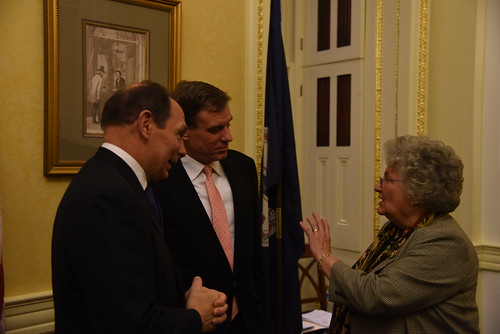Priorities
By: Hugh Lessig

VA Secretary Robert McDonald, Sen. Mark Warner, NVTC President and CEO Bobbie Kilberg
The Department of Veterans Affairs has embraced 39 recommendations from the Northern Virginia Technology Council on improving patient care and wait times at VA medical centers.
The report, based partly on visits to the Hampton and Richmond VA medical centers, was released last year and came after Sen. Mark R. Warner enlisted the council's help.
Warner and VA Secretary Robert McDonald met council members Tuesday at the Capitol to congratulate them. The senator, himself a former high-tech businessman from that region, said the report offered practical solutions and "didn't cost taxpayers a dime."
"We couldn't be more thrilled," said McDonald, who thanked council members and VA staffers who showed "an open mind and a willingness to learn to change."
The VA has fully implemented 26 recommendations, and McDonald said he is committed to enacting all the suggestions in the report. Warner thanked the VA for welcoming the team, although it didn't happen as fast as he wanted.
The council issued the report in October 2014 after a six-week review that included visits to the two centers. Seven months later, the senator said he was frustrated that the VA hadn't acted on the report.
Recommendations in the 125-page document cover 13 areas, including scheduling, communications, technology, recruitment/hiring, training and patient wait times.
The VA heeded the advice from Bobbie Kilberg, council president and CEO, who had cautioned against "cherry picking" recommendations, because many are interrelated.
About half the recommendations focus on the job duties of specific people, but the report's authors cautioned against interpreting this as criticism of staff members who aren't doing their job.
It says VA schedulers, heath-care providers and other staff "work quite hard — indeed, much harder than should ever be necessary" to compensate for problems related to technology, processes or resources.
For example, doctors and nurses are more productive when they have two exam rooms instead of one. The report's authors noted a shortage of exam space during their 2014 site visits.
Hampton addressed this problem in March. It created 15 exam rooms and 12,000 square feet of clinical space from what had been administrative offices. Patient workload at Hampton had grown nearly four times higher than the national average.
Another recommendation in the report — stronger financial incentives for hiring — has also paid dividends at Hampton. Administrators announced this summer that the medical center has overcome the loss of nine doctors by hiring a dozen health-care providers, a mix of physicians, nurse practitioners and physician assistants.
Financial incentives are "especially critical for a location like Hampton, where the VA must compete head-on with the Department of Defense in the health care provider market place," the report states.
Although the findings are based on site visits to only two VA medical centers, "we are reasonably confident that the findings are generalizable to many other VA medical facilities," the report states. That's because the findings are very similar to a 2008 study that involved visiting 25 VA medical centers and other community health clinics.